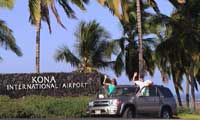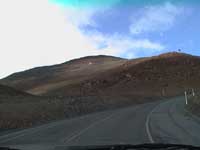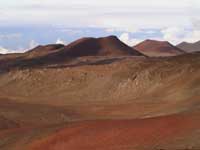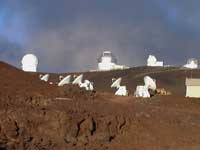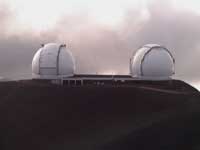 |
||||||||||||||||||||||
We flew from Oahu to Hawaii early this morning and rented a big four-wheel drive SUV to drive to the top of the tallest mountain in world -- Mauna Kea! You may have thought that Mt. Everest is the tallest mountain in the world. That is true if you measure the height above sea level (Mt. Everest - 29,035 feet (8,850 meters). Mauna Kea - 13,796 feet (4,205 meters). If you measure from the base of the mountain to the top, Mauna Kea is taller. From the base of the mountain on the ocean floor it is 33,476 feet (10,203 m) tall! (How deep is the ocean here?) Unlike Mt. Everest we don't have to make a dangerous climb to the top of the mountain...We can drive there! The Hawaiian Islands are all the tops of volcanoes that are sticking out of the ocean, so we are driving up a volcano! The island of Hawaii is not one big volcano. It is actually made out of five big volcanoes! The largest of the five volcanoes is Mauna Loa, but the tallest is Mauna Kea. Mauna Kea last erupted 4,000 years ago, and volcanologists believe that it will erupt again in the future. We hope it doesn't erupt while we are on top of it! It is a long drive from the Kona Airport to the road that goes to the top of Mauna Kea. The road climbs up between both Mauna Loa and Mauna Kea. We drive along a road that winds around, over and through old fields of black lava. We drive up to 6,500 feet as we look for the turn-off that goes to the top. We think we may have missed the turn-off as the road starts heading down. We turn around and go back up the mountain. Sure enough! About a half hour later we find the turn-off we missed. We turn on to a narrower road that winds steeply up the mountain. Another half hour and we reach the small visitor center. We stop here to look around. The park ranger tells us that we should stay here for about half an hour. This will allow our bodies to adapt to the lack of oxygen on the mountain. The altitude here is 9,000 feet. At the top it is about 14,000 and some people get altitude sickness. Altitude sickness is very dangerous and some people can die from it. The ranger tells us that if we get the symptoms of altitude sickness (headache, hard to breathe, tunnel vision) we have to come back down immediately because the sickness will go away at a lower altitude. At the visitor center we change into warm clothes. It is cool here and it will be cold on top of the mountain. In the winter time it even snows here! That is how Mauna Kea got its name which means "White Mountain". After waiting the required time we start our drive to the top. The road is now rough gravel. The road is dangerous so only 4-wheel drives are allowed to go to the top. We have now driven up into the clouds. If is so foggy that we can hardly see the road! We drive very slowly because there are no guard rails and we can only see about 20 feet around us! After about 45 minutes we pop out of the clouds. We are so high that we are above the clouds! The road is now paved. Since we are above the clouds we can see all around us. It looks very weird. Nothing is growing here. It is all reddish volcanic lava, ash and rock. Volcanic cinder cones stick out of the ash. It looks like we just landed on Mars, the red planet! (Maybe in the future some of you will get to visit Mars for real!) Finally we make it to the top. There is still nothing growing here, but there are lots of telescope domes and some radio telescopes, too. Nine countries have their telescopes up here. There are more telescopes here than any place in the world! We go to visit the two largest optical telescopes in the world and find out we can't see them. The observation platform inside closed about 30 minutes ago. If we hadn't missed the turn-off we would have made it in time. Oh, well... Astronomers like having their telescopes way up here because there is less atmosphere to cause distortions in their viewing into space. Also there are no lights nearby that would make it harder to view the stars clearly. From up on top of Mauna Kea the whole northern sky can be viewed and 90% of the southern sky. It is late in the day so we take the remaining daylight to drive around and explore the Martian-like landscape on the volcano. Fortunately neither one of us is getting altitude sickness! The sun is going down and we were planning on looking at Mars from up here, after dark. We meet a park ranger up here who tells us that if we go back down to the vistor center we will see more stars. That is because with less oxygen up here our eyes don't work as well so we will see less stars at this altitude. For that reason the astronomers don't work up here either. At the bottom of the volcano, in the town of Waimea, is the astronmy center. That is where the astronomers work. They control and look through the telescopes using computers! After watching a beautiful sunset we drive back down to the visitor center. There are telescopes already set-up for us. We get to see Mars and its large polar ice cap...If there is ice there could be water. We wonder if there would be enough water to scuba dive in? When we scuba dive we explore inner space. Tomorrow we will look at how scientists explore outer space. Join us tomorrow as we visit the Mauna Kea Observatory Support Services Center in Waimea and learn how the scientists use these telescopes. We will also learn how someone (one of you maybe?) can become an astronomer. Cool wishes, |
TODAY'S DATA Mauna Kea, Hawaii Position: 19º 49' N / 155º 28' W We are leaving the Kona airport on our way to drive to the top of the tallest mountain in the world!
We are driving up above the clouds to the top of the volcano, Mauna Kea! You can see that nothing is growing here. It is just volcanic ash and rock.
The top of Mauna Kea looks like the surface of Mars!
On top of Mauna Kea there are more telescopes than any place in the world! (The 5 dishes in front are radio telescopes. The domes are all optical telescopes.)
These two telescopes are the largest optical telescopes in the world! (For an idea how big they are, enlarge the photo -- the three light-colored boxes in the center, between the telescopes, are SUVs!) |
|||||||||||||||||||||
home | basecamp | archives | library | other expeditions | kids' page | contact us © 2003, The Ocean Adventure All rights reserved. |
